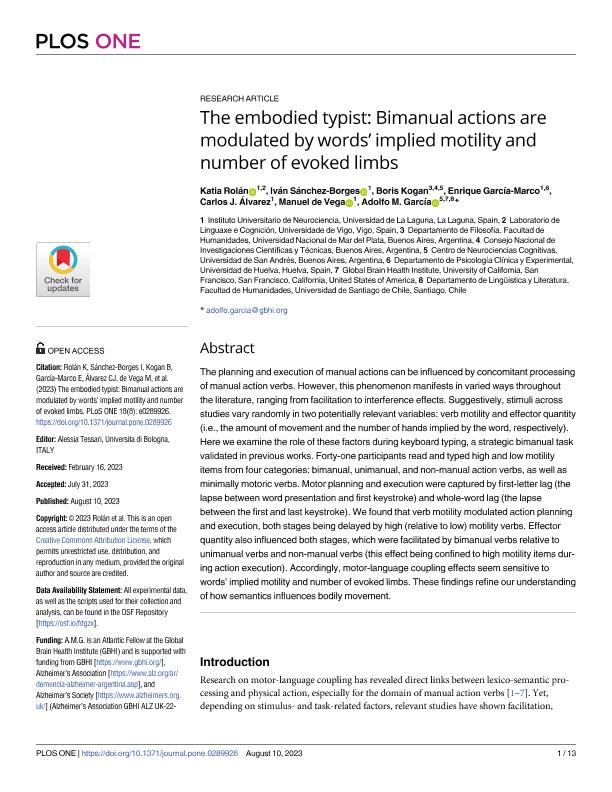Artículo
The embodied typist: Bimanual actions are modulated by words’ implied motility and number of evoked limbs
Rolán, Katia; Sánchez Borges, Iván; Kogan, Boris ; García Marco, Enrique; Álvarez, Carlos J.; de Vega, Manuel; García, Adolfo Martín
; García Marco, Enrique; Álvarez, Carlos J.; de Vega, Manuel; García, Adolfo Martín
 ; García Marco, Enrique; Álvarez, Carlos J.; de Vega, Manuel; García, Adolfo Martín
; García Marco, Enrique; Álvarez, Carlos J.; de Vega, Manuel; García, Adolfo Martín
Fecha de publicación:
08/2023
Editorial:
Public Library of Science
Revista:
Plos One
ISSN:
1932-6203
Idioma:
Inglés
Tipo de recurso:
Artículo publicado
Clasificación temática:
Resumen
The planning and execution of manual actions can be influenced by concomitant processing of manual action verbs. However, this phenomenon manifests in varied ways throughout the literature, ranging from facilitation to interference effects. Suggestively, stimuli across studies vary randomly in two potentially relevant variables: verb motility and effector quantity (i.e., the amount of movement and the number of hands implied by the word, respectively). Here we examine the role of these factors during keyboard typing, a strategic bimanual task validated in previous works. Forty-one participants read and typed high and low motility items from four categories: bimanual, unimanual, and non-manual action verbs, as well as minimally motoric verbs. Motor planning and execution were captured by first-letter lag (the lapse between word presentation and first keystroke) and whole-word lag (the lapse between the first and last keystroke). We found that verb motility modulated action planning and execution, both stages being delayed by high (relative to low) motility verbs. Effector quantity also influenced both stages, which were facilitated by bimanual verbs relative to unimanual verbs and non-manual verbs (this effect being confined to high motility items during action execution). Accordingly, motor-language coupling effects seem sensitive to words’ implied motility and number of evoked limbs. These findings refine our understanding of how semantics influences bodily movement.
Palabras clave:
EMBODIED COGNITION
Archivos asociados
Licencia
Identificadores
Colecciones
Articulos(SEDE CENTRAL)
Articulos de SEDE CENTRAL
Articulos de SEDE CENTRAL
Citación
Rolán, Katia; Sánchez Borges, Iván; Kogan, Boris; García Marco, Enrique; Álvarez, Carlos J.; et al.; The embodied typist: Bimanual actions are modulated by words’ implied motility and number of evoked limbs; Public Library of Science; Plos One; 18; 8; 8-2023; 1-13
Compartir
Altmétricas



